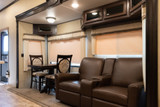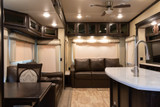Choosing the Best RV for Your Next Adventure
Are you set on picking up a recreational vehicle for an upcoming road trip, camping excursion or family vacation? If so, it’s important to understand and consider all of your options before investing in one of these luxurious rides. After all, there’s a massive selection of RVs to choose from, and each option has distinct perks. At Restore RV™, our mission is to provide you with all of the information and tools you need to experience the best RV trips possible. Today, we’ll be comparing some of the most popular types of recreational vehicles to help you determine which will work best for your next adventure.
1. Class A Motorhomes
Class A motorhomes are some of the largest RVs available, often resembling semi-trucks or buses. Their size can range between 21 and 45 feet, which is why they’re usually constructed on a specially designed commercial truck chassis. Their massive size allows them to accommodate up to eight people and carry a variety of fun amenities and toys (including high-quality RV furniture, washers, dryers, full bathrooms and more), making them one of the most comfortable and enjoyable rides around. These vehicles can also be outfitted with gas or diesel engines, “basement storage” on the underside of the chassis, front or rear engines and hydraulic jacks to keep the vehicle level when it’s parked, offering you superb customization options.
Regrettably, all of these great features don’t come cheap. Picking up a basic Class A motorhome could cost you anywhere between 50,000 and 150,000 dollars. It’s also worth noting that filling up this vehicle’s gas tank completely will cost at least 250 dollars. (One tank of gas will take a Class A motorhome anywhere between 800 and 1,500 miles.) Additionally, these huge vehicles can run into problems when forced to navigate through winding or narrow roads, tunnels, low overhangs and small campgrounds, which is why it’s imperative to take factors like these into consideration when planning out your trip.
Class A Motorhomes are ideal for:
- Long road trips
- Full-time RV living
- Large families or traveling groups
2. Class B Motorhomes
Often referred to as camper van conversions, Class B motorhomes are essentially compact RVs that are built on minivan or full-size van chassis. They’re usually about 15 to 26 feet long and can be equipped with either gas or diesel engines. These RVs can also be upgraded with slide-out areas (for even more space) and pop-up roofs. Typically, Class B motorhomes can only accommodate about three people, but larger variants can seat up to five people and have sleeping space for four, making them a fantastic choice for small families or groups of friends.
Despite their small size, Class B motorhomes are still relatively expensive. Depending on the size and amenities you choose, new models will cost you around 40,000 to 80,000 dollars. However, they’re much easier to drive than Class A vehicles and won’t put as much pressure on your finances when you need to fill up the tank. Furthermore, these rides will fit in normal parking spaces and garages, making the process of storing them or getting them into camp sites effortless compared to larger RVs. One of the biggest downsides of Class B motorhomes is their limited passenger capacity. Unless you purchase one of the largest (and most expensive) models, you’ll only be able to comfortably ride with two other people.
Class B Motorhomes are ideal for:
- Solo RV trips
- Small families or traveling groups
- Camping adventures
3. Class C Motorhomes
Class C motorhomes (also known as mini-RVs) are essentially the little cousins of Class A motorhomes. They’re mid-sized vehicles that provide most of the convenience of larger models at a substantially lower price. Class C motorhomes are typically built on large van or truck chassis and can reach up to 36 feet in length. Larger models can comfortably accommodate about six people. This type of RV is a perfect compromise between Class A and B motorhomes. If you have a small travel group, these vehicles will give you a fantastic amount of free space, which you can put to good use by picking up an electric RV fireplace or a classy recliner sofa. Additionally, larger groups can save significant amounts of money by choosing a Class C over a Class A, but you might be pressed for space.
Buying a new Class C motorhome with basic features will cost you around 50,000 to 80,000 dollars. You can also invest in larger models with upgraded appliances, larger bathrooms and exterior storage spaces, but these can cost anywhere between 85,000 to over 140,000 dollars. We definitely recommend this type of RV for mid-sized traveling groups or small groups that want to enjoy extra room or pack extra gear into their ride. Once again, big groups can make this model work as well, but only if they’re comfortable with traveling light.
Class C motorhomes are ideal for:
- Long road trips
- Mid-sized families or traveling groups
- Small groups that want extra space
Note: It would take a much longer post to cover every type of RV you could purchase. We haven’t even mentioned truck campers, pop-ups, travel trailers, park models, toterhomes and many others. Be sure to check online if you’re interested in learning about even more RV variants.
Recent Posts
-
How to Keep Your Pets Safe While Camping
RVing and camping are a great getaway from the hustle and bustle of work and the city and the day-to …Jul 2nd 2024 -
Why Replace Your RV Furniture?
You may wonder when is the best time to replace your RV furniture. There is no one right answer to t …May 20th 2024 -
Can You Put Regular Furniture in an RV?
Many new and old RV owners ask themselves this question when they feel the need to update th …Apr 25th 2024 -
4 Tips for Securing RV Furniture While Traveling | RecPro
How To Secure RV Furniture There are few things that beat going out on an adventure with an RV …Apr 25th 2024 -
How To Keep RV Furniture From Peeling
Peeling RV Furniture | Why it Peels and How to Stop it Your RV furniture is a point of pride on yo …Apr 25th 2024 -
Turning up the Heat With an RV Fireplace
There’s an unlimited number of cool and exciting features you could add to your recreational vehicle …Apr 25th 2024







